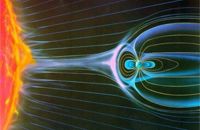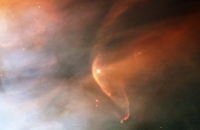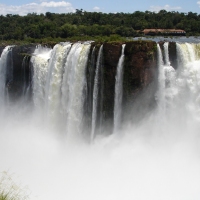Cluster shows how solar wind is heated
16 July 2009
Using data from the Cluster mission scientists have discovered a mechanism that can account for the heating of the solar wind. Cluster data were used to successfully discriminate between a number of theoretical models and, for the time periods analyzed, a remarkable agreement was found with one model in particular. This result may be applicable in other astrophysical contexts such as the heating of the solar corona. This discovery was highlighted in the 12 June 2009 issue of Physical Review Letters.The Sun not only provides our daylight, it also constantly expels a supersonic flow of charged particles. This solar wind is mostly composed of electrons and protons. It travels across the solar system where it interacts with different objects, such as planets and comets (Figure 1a). Similarly, interstellar winds impact other star systems, as evidenced by the Hubble Space Telescope (Figure 1b).
Even after decades of studying the solar environment with missions such as Ulysses and SOHO many questions remain unanswered about the solar wind. For instance, the solar wind arises because the extreme temperature of its source region, the solar corona, enables matter to escape the Sun's gravity. The solar corona is located millions of kilometres above the Sun's surface, the photosphere, however, the photosphere has an estimated temperature of 'only' 6000 degrees. The heating mechanism of the solar corona is unclear and has been an open question for decades. Similarly, heating of the solar wind itself is also observed up to 50 Astronomical Units (AU) from the Sun (1 AU is the average distance between the Sun and Earth).
Electromagnetic fluctuations, including waves and turbulence, are a likely source for this heating, both in the lower corona and in the solar wind. But so far, exactly how turbulence heated the matter composing the solar wind remained unclear.
Using measurements obtained by the Cluster mission, scientists on both sides of the Atlantic have managed to trace the flow of energy in the solar wind as it is transferred from large scales (100 000 km), where it is input, to small scales (~3 km) where it is dissipated (Figure 2). The challenge is a bit like understanding how the energy is transferred from the laminar flow of a river down to the small turbulent eddies and foam formed at the bottom of the falls (Figure 3).
"For the first time, we could show that only a fraction of the energy of the turbulence goes to the protons while most of it continues cascading down to smaller scales, in fact to the electron scale. In other words, the true dissipation scale of the turbulence, where the energy goes into heat, is at the electron scale", says Fouad Sahraoui, lead author of the study.
This result could improve the theoretical models which describe heating of the corona and the solar wind. Indeed, the heating as evidenced here is shown to happen via damping of the turbulence by Landau resonances rather than cyclotron ones, which are generally evoked to heat the solar corona. It is also shown that damping of turbulence by electrons is more important and efficient than by protons, which may be considered in global modelling of heat fluxes and radiation in the corona. More generally, this new vision of turbulence, where a large amount of energy is deposited onto electrons may be applicable in other astrophysical contexts where electrons are heated or accelerated (for example, accretion disks around stars and the acceleration of cosmic rays).
“This research is based on a case study. Further research is required to assess the statistical validity of this promising result”, added Sahraoui.
“The Cluster mission delivers what it has been designed for: studies of the Sun-Earth connection in three dimensions with state-of-the-art instrumentation. With more than 250 refereed papers published over the past 18 months and more than 1,000 in total, Cluster is going stronger than ever. It is rewarding to see how the long-term support provided by ESA and NASA continues to pay off”, says Matt Taylor, acting ESA Project Scientist of the Cluster mission.
Reference publication
Sahraoui, F., Goldstein, M.L., Robert, P., Khotyaintsev, Y.V., Evidence of cascade and dissipation of solar wind turbulence at electrons scales, Physical Review Letters, 02, 231102 (2009). DOI: 10.1103/PhysRevLett.102.231102
Contact
Fouad Sahroui, NASA/GSFC, USA, on leave from the Laboratoire de Physique des Plasmas, CNRS-Ecole Polytechnique, France.
Email: fouad.sahraoui-1 nasa.gov
nasa.gov
Web story author and co-editor
Arnaud Masson, Science and Robotic Exploration Directorate, ESA, The Netherlands.
Email: Arnaud.Masson esa.int; Phone: +31-71-565-5634
esa.int; Phone: +31-71-565-5634
Web story editors
Matt Taylor
Science and Robotic Exploration Directorate, ESA, The Netherlands.
Email: Matthew.Taylor esa.int; Phone: +31-71-565-8009
esa.int; Phone: +31-71-565-8009
Philippe Escoubet
Science and Robotic Exploration Directorate, ESA, The Netherlands.
Email: Philippe.Escoubet esa.int; Phone: +31-71-565-4564
esa.int; Phone: +31-71-565-4564





